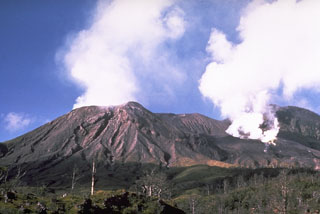Report on Langila (Papua New Guinea) — 24 May-30 May 2017
Smithsonian Institution / US Geological Survey
Weekly Volcanic Activity Report, 24 May-30 May 2017
Managing Editor: Sally Sennert.
Please cite this report as:
Global Volcanism Program, 2017. Report on Langila (Papua New Guinea) (Sennert, S, ed.). Weekly Volcanic Activity Report, 24 May-30 May 2017. Smithsonian Institution and US Geological Survey.
Langila
Papua New Guinea
5.525°S, 148.42°E; summit elev. 1330 m
All times are local (unless otherwise noted)
Based on analyses of satellite imagery and wind model data, the Darwin VAAC reported that during 24-27 May ash plumes from Langila rose 2.1-3 km (7,000-10,000 ft) a.s.l. and drifted 75-85 km W and NW.
Geological Summary. Langila, one of the most active volcanoes of New Britain, consists of a group of four small overlapping composite basaltic-andesitic cones on the lower E flank of the extinct Talawe volcano in the Cape Gloucester area of NW New Britain. A rectangular, 2.5-km-long crater is breached widely to the SE; Langila was constructed NE of the breached crater of Talawe. An extensive lava field reaches the coast on the N and NE sides of Langila. Frequent mild-to-moderate explosive eruptions, sometimes accompanied by lava flows, have been recorded since the 19th century from three active craters at the summit. The youngest and smallest crater (no. 3 crater) was formed in 1960 and has a diameter of 150 m.

